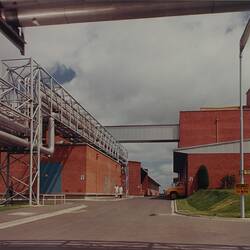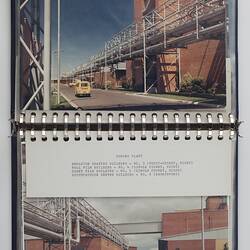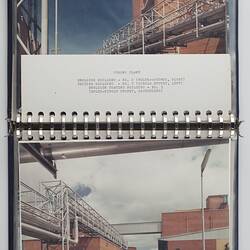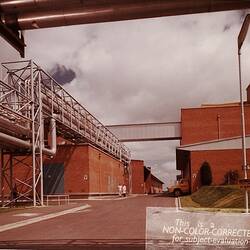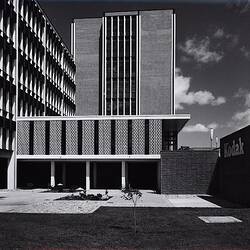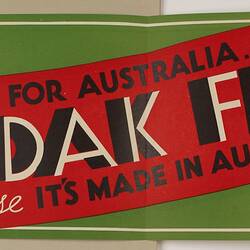Summary
Colour photograph taken by Wolfgang Sievers of a view looking west along a road servicing Building 7, Testing; Building 3, Emulsion Coating and Building 2, Emulsion Making, at the newly constructed Kodak Australasia Pty Ltd factory complex in Coburg, 1964.
The photograph was chosen to feature in an album prepared for the Kodak parent company at Rochester, in New York State, USA.
A connecting bridge at third floor level between Buildings 2 and 3 is visible above the road, as well as a services gantry above and to the left of the road above Building 7. All services to the factory buildings were reticulated from a central power house via a gantry system. The plant and layout of the Power House (Building 11) was chosen to provide a high degree of energy efficiency and standby capacity. The gantry carried the following services: chilled water at 3ºC for cooling and air conditioning; ethylene-glycol brine at -9ºC for chill rooms, low dew point drying and emulsion chilling; saturated steam at 70Kpa for emulsion heating and air conditioning; saturated steam at 700KPa for emulsion heating; condensate return to boilers; compressed air at 550KPa for machine actuation and instrument controls; electrical cables at 415V 50Hz 3phase, distilled water and clarified water for emulsion making and testing. The steam, chilled water and brine pipes were all heavily lagged and clad for efficiency and protection reasons. The steam pipes in particular had large loop sections to allow for expansion.
Construction of the Coburg complex began in 1957 on twenty three hectares of former farmland. Since 1908, Kodak had been operating from the factory in Abbotsford and had gradually outgrown the premises. The Abbotsford factory remained operational while the Coburg plant was being built until it closed in1966. Architect Harry Norris of H A & F L Norris & Associates, created the design for the new factory and individual buildings, while the building contract was awarded to Lewis Constructions Pty Ltd.
The still uncompleted Coburg factory complex was officially opened on 14 April 1961 by the Prime Minister, Robert G. Menzies with Dr. A Chapman, President of Eastman Kodak Company, in attendance. The complex was the national headquarters of Kodak Australasia Pty Ltd and its manufacture of silver halide photographic products. It replaced the Abbotsford factory where Kodak had been operating since 1908. The Abbotsford premises eventually closed in 1966.
Wolfgang Sievers is widely recognised as one of Australia's most significant architectural and industrial photographers. He pioneered a modernist photographic style influenced by the Bauhaus, and his work celebrates industry and the worker. Sievers was commissioned to document the newly constructed Kodak Coburg plant. He subsequently took several hundred black & white and colour images that highlighted the modern architectural and industrial design features of the complex.
Kodak manufactured and distributed a wide range of photographic products to Australasia, such as film, paper, chemicals, cameras and miscellaneous equipment. Its client base included amateur and professional photographers, as well as specialist medical and graphic art professionals who used photography, x-ray and other imaging techniques.
This photograph is part of the Kodak collection of products, promotional materials, photographs and working life artefacts collected from Kodak Australasia in 2005, when the Melbourne manufacturing plant at Coburg closed down.
Description of Content
Photograph of a view along a road with buildings either side. A connecting bridge at third floor level is visible between two of the buildings. A service gantry can also be seen to the left of the road above a building. Two people are walking along the road and a yellow truck is parked at a docking bay of the building to the right.
Physical Description
Colour photograph printed on light weight paper, landscape format.
More Information
-
Collection Names
-
Collecting Areas
-
Acquisition Information
Donation from Kodak (Australasia) Pty Ltd, Ms. Kate Metcalf - Kodak (Australasia) Pty Ltd, 2005
-
Acknowledgement
Courtesy of Kodak (Australasia) Pty Ltd.
-
Place & Date Depicted
Coburg, Greater Melbourne, Victoria, Australia, 1964-1965
Album was compiled in about 1965 according to an inscription in the album. In the invoice [see HT 20552], dated 28th August 1964 from Sievers to Kodak regarding the commission of photographs of the Coburg factory complex, Sievers mentions the postponement of some external images until landscaping had been completed. This suggests a later creation date needs to be posited for photographs, possibly 1965 [circa 1965], for a group of black and white as well as colour externals that feature a different serial number [3613] from the serial number in the invoice [3562]. -
Organisation Depicted
Kodak (Australasia) Pty Ltd, Coburg, Greater Melbourne, Victoria, Australia, 1964
Album was compiled in about 1965 according to an inscription in the album. -
Organisation Depicted
Wolfgang G. Sievers AO, Coburg, Greater Melbourne, Victoria, Australia, 1964
-
Format
Photograph, Colour
-
Inscriptions
Card insert, typed, black ink: 'COBURG PLANT/ EMULSION BUILDING - NO.2 (MULTI-STOREY, RIGHT)/ TESTING BUILDING - NO.7 (SINGLE STOREY, LEFT)/ EMULSION COATING BUILDING - NO.3/ (MULTI- STOREY, (BACKGROUND)' Back, stamp, purple ink: 'WOLFGANG SIEVERS / Photographer / 9 COLLINS ST. MELBOURNE C. 1. / TELEPHONE 63-4023' Back, handwritten, pencil: 'EC-3252 D'
-
Brand Names
-
Classification
Manufacturing & industry, Photographic products, Factory exterior views
-
Category
-
Discipline
-
Type of item
-
Image Dimensions - Photograph
239 mm (Width), 190 mm (Height)
-
References
Beale, N, The History of Kodak in Australia, Coburg, no date. [Link 1] "A Brief Process Based Site History, Kodak (Australasia) Pty Ltd, Coburg Plant" Kodak (Australasia) Pty Ltd, 2007 Pamphlet, "Milestones in the History of Kodak (Australasia) Pty. Ltd", Kodak (Australasia) Pty. Ltd., 1985 Leggio, Angeletta "A History of Australia's Kodak Manufacturing Plant", Topics in Photographic Preservation, Volume Twelve, 2007 Ennis, Helen "Intersections: Photography, History and the National Library of Australia", National Library of Australia, Canberra, 2004
-
Keywords
Buildings, Factories, Gantries, Manufacturing Plants, Motor Vehicles, Photography, Making History - Kodak Collection

